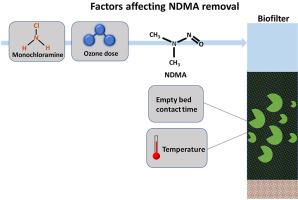Chemosphere ( IF 8.1 ) Pub Date : 2020-09-24 , DOI: 10.1016/j.chemosphere.2020.128333 Ramola Vaidya , Christopher A. Wilson , Germano Salazar-Benites , Amy Pruden , Charles Bott

|
N-nitrosodimethylamine (NDMA) is a carcinogen and a disinfection byproduct that is formed by ozone and combined chlorine. Various factors affecting NDMA formation and removal were examined at pilot-scale for a treatment train consisting of ozone, biologically-active carbon (BAC) filtration, and granular activated carbon (GAC) adsorption applied to two distinct feed waters. High concentrations of ozone and monochloramine were added to the influent, demonstrating that ozone removed monochloramine precursors of NDMA. Further, longer empty bed contact times (EBCTs) of 10 min for BAC and 10 and 20 min for GAC removed NDMA to <10 ng/L for both feed waters. NDMA removal by the BAC process was most favorable >22 °C, presumably due to elevated microbial activity. A monochloramine residual of 3 mg/L-Cl2 in the BAC influent reduced NDMA removal in the 5 min EBCT BAC from 79% to 36% and in the 10 min EBCT BAC from 88.5% to 73.7%. The absence of ozone in the treatment process significantly reduced NDMA formed post ozone, but decreased NDMA removal in BAC, probably due to lower NDMA concentration in the BAC influent. Finally, adding 5 mg/L of allylthiourea, an inhibitor of ammonia-oxidizing bacteria, indicated that removal mechanisms for ammonia and NDMA are distinct. However, nitrification is still a good indicator for NDMA biodegradation potential, because nitrifying bacteria appear to flourish under similar EBCT, temperature. and monochloramine residual conditions during BAC filtration.
中文翻译:

臭氧生物滤池中水回用过程中影响NDMA去除的因素
N-亚硝基二甲胺(NDMA)是一种致癌物,是由臭氧和氯结合形成的消毒副产物。在中试规模下,研究了影响NDMA形成和去除的各种因素,包括臭氧,生物活性炭(BAC)过滤和颗粒活性炭(GAC)吸附应用于两种截然不同的给水的处理过程。高浓度的臭氧和一氯胺被添加到进水中,表明臭氧去除了NDMA的一氯胺前体。此外,较长的空床接触时间(EBCT)对于BAC而言为10分钟,对于GAC而言为10至20分钟,这两种补给水的NDMA去除率均小于10 ng / L。通过BAC工艺去除NDMA最有利于> 22°C,这可能是由于微生物活性提高所致。一氯胺残留量为3 mg / L-Cl 2BAC进水中的NDMA去除量在5分钟EBCT BAC中从79%降低到36%,在10分钟EBCT BAC中从88.5%降低到73.7%。在处理过程中不存在臭氧会显着减少臭氧后形成的NDMA,但会降低BAC中NDMA的去除,这可能是由于BAC进水口中NDMA浓度降低所致。最后,添加5 mg / L的烯丙基硫脲(一种氨氧化细菌的抑制剂)表明,氨和NDMA的去除机理是不同的。但是,硝化仍然是NDMA生物降解潜力的良好指标,因为硝化细菌在相似的EBCT温度下似乎会蓬勃发展。和BAC过滤过程中的一氯胺残留条件。











































 京公网安备 11010802027423号
京公网安备 11010802027423号